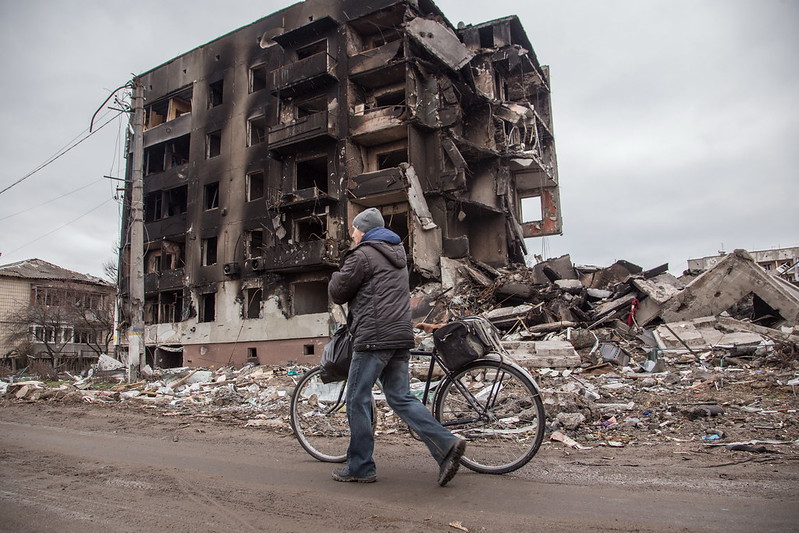Five things to know about the New Agenda for Peace
September 19, 2023

The conflict in Ukraine has shown that in our interconnected world, the consequences of conflict reverberate beyond national borders.
Every September, the United Nations hosts leaders from across the world in New York for the UN General Assembly. This year, as part of the Sustainable Development Goals (SDG) Summit, the international community gathered to assess progress on achieving its goals. Amid this vital gathering, turbulence and uncertainty have taken centre stage.
Twenty-five percent of the world’s population now lives in conflict-affected areas. Last year the number of conflict-related deaths reached a 28-year high. Global peacefulness has declined over the past 15 years, reaching the lowest levels since the second world war. We are experiencing a record decline in global trust and human security and an erosion of social cohesion. These worrying trends are compounded by the climate crisis, the soaring cost of living, rising inequality and exclusion, and a record number of people who have been forcibly displaced.
Recent events in Niger serve as a striking example of an alarming trend of coups and unconstitutional changes in government casting a shadow over stability and democracy. These trends highlight the need for democratic renewal and a reset of the social contract, as well as indicating the need for the international community to refocus its efforts to support prevention in crisis and fragile settings.
As we commemorate the 2023 International Day of Peace, we stand at a crossroads. The challenges before us demand a critical reevaluation of our efforts to address the conflicts that trouble our world. Now more than ever we must step up our collective commitment to peace and upgrade our capabilities to prevent violence in all forms if we are to deliver on the central promise of the UN and support societies on paths to sustaining peace.
UN Secretary-General António Guterres recently launched a New Agenda for Peace, presenting a vision for how the international community can more effectively prevent conflict and sustain peace at a moment when the world is experiencing unprecedented and overlapping crises.
On this International Day of Peace, we share our five key takeaways on what the New Agenda for Peace means for peacebuilding:
1) In an increasingly fragmented world, we need to rebuild trust, solidarity and accountability. Platforms like the International Dialogue on Peacebuilding and Statebuilding (IDPS) can help.
To succeed in our global peace efforts and prevent conflict, we must rebuild vital bonds of trust, solidarity, and mutual accountability. The New Agenda for Peace reminds countries that international co-operation does not require them to forgo their national interests and encourages them to recognize that they have shared goals. The IDPS represents an ideal forum to overcome such divisions and model political dialogue and preventive diplomacy. This week it launched a joint statement calling for an urgent need to accelerate collective action towards progress on SDG 16 on peace, just and inclusive societies.
2) Supporting national ownership of prevention is more critical than ever.
The New Agenda for Peace re-emphasizes the responsibility of member states to sustain peace domestically and calls on them to develop national and regional prevention strategies, reframing prevention as a national agenda. UNDP has worked to empower national stakeholders to strengthen existing mechanisms and capacities for inclusive dialogue, insider mediation and national peace architectures, including through the signature Joint UNDP-UN Department of Political and Peacebuilding Affairs programme on Building National Capacities for Conflict Prevention.
3) New solutions require new voices at the decision-making table.
To tackle the complex, multidimensional causes that drive conflict and enable it to persist, the New Agenda for Peace underscores that we need to mobilize a wide range of partners. From working with social media and tech companies to better understand and address the role of new technologies in driving division, hate and conflict, and the private sector on innovative financing for peace, to regional organizations, human rights defenders and local governments, UNDP is developing partnerships that are bringing new partners and ideas to the peace table.
4) Inclusivity is paramount for peace to be achievable and sustainable.
Many people who are most affected by conflict and violence remain on the sidelines of decision making. This is particularly true for women, young people, and other marginalized groups who struggle to be regarded as trusted and reputable resources. Yet local communities and peacebuilders have the knowledge and legitimacy to make critical strides towards peaceful societies. In partnership with the EU, UNDP is supporting grassroots peacebuilders across the globe promoting local ownership.
5) Prevention should be a universal goal for every country, not just those experiencing conflict.
The conflict in Ukraine has shown that in our interconnected world, the consequences of conflict reverberate beyond national borders. This interconnectedness means that prevention does not only apply to conflict-affected or fragile states. All countries need to recognize and commit to preventing and sustaining peace. The evidence is clear: investing in prevention saves lives and resources, with potential savings between US$698 million and $1.5 billion per year. UNDP’s Prevention Academy provides capacity-building for conflict prevention in the UN family and beyond, advocating for peacebuilding in theory and practice at the local, national and international level. UNDP is using this learning and expertise to to anticipate and prevent conflict by supporting contexts around the globe, from Kosovo1 to Madagascar.
It is imperative that we create a collective vision of a more peaceful world. The New Agenda for Peace does not just offer words; it presents an opportunity. UNDP is committed to working with partners from across the peace spectrum to translate this vision into action.
For information on UNDP’s work on Conflict Prevention and Peacebuilding, please contact Helena Sterwe, Team Leader on Conflict Prevention and Peacebuilding, UNDP Crisis Bureau at Helena.sterwe@undp.org
1 All references to Kosovo should be understood to be in the context of United Nations Security Council resolution 1244 (1999)

 Locations
Locations
